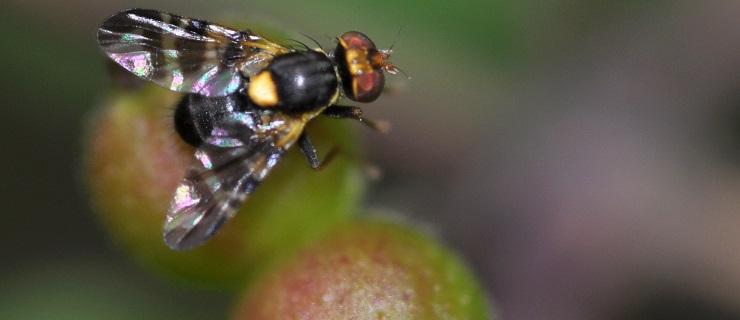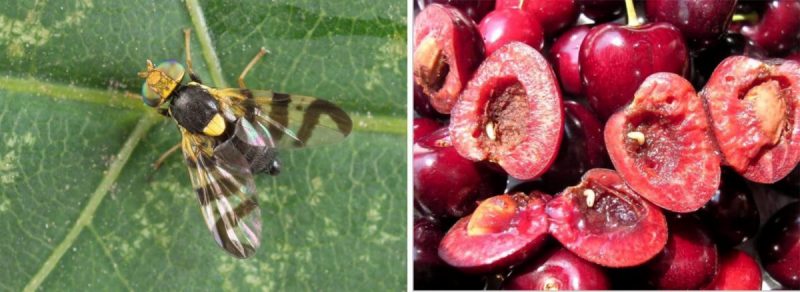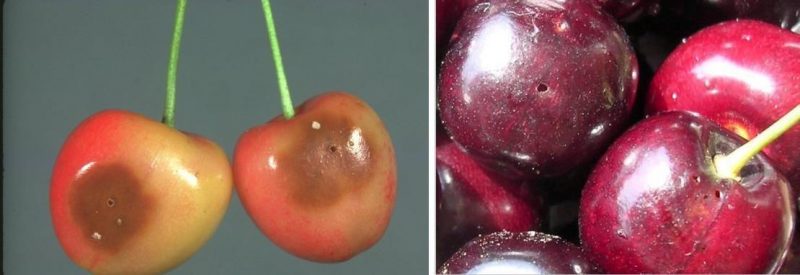The European cherry fruit fly (Rhagoletis cerasi) – pest management

Prevalence. The European cherry fruit fly is widespread in several countries in Europe and North America, in cherry and sour cherry orchards.
Description. The adult is a small fly, 3-5 mm long, with a black body and transparent wings, with 3 transverse stripes, wide, blackish-brown. The fly has the head, the scutellum, and the tip of the feet colored in reddish-yellow. The larva doesn’t have any legs, is white-yellow, 5-6 mm long.
Biology and ecology
This insect produces one generation per year and overwinters in the pupal stage in the surface layer of the soil (at a depth of 2-18 cm), under the crown of trees. The adults appear about a month before the cherries and sour cherries ripen, at the end of May. 1-2 weeks after they start flying, the copulation and laying of the eggs take place. The female lays an egg under the epidermis of the fruit in the dough ripeness. A female can lay up to 200 eggs. The larvae hatch after 6-12 days and penetrate the fruit, feeding on the pulp of the fruit, so that, after the attack, the tissues become soft and darken in color. After feeding for 3-4 weeks, the fully developed larvae leave the fruit and migrate to the soil to become pupae, the stage in which the insect overwinters. Some pupae may remain in diapause for up to 2-3 years.
Sunny weather and temperatures of 18-22° C are favorable conditions for the development of this species. Heavy rainfall has a negative impact on flies.
Attacked plants and damages
The European cherry fruit fly is the most important pest of cherries. The damage is caused by the larva of this species, which attacks the fruit, consuming the pulp around the seed. The attacked fruits become soft, darken, rot and fall off. Even after harvest, the attacked fruits are sensitive and rot.
Varieties with semi-late and late-ripening are prone to its attack. Usually, early varieties are not attacked by the European cherry fruit fly. The pest has also been reported on the fruits of Lonicera tatarica, Lonicera xilosteum, Berberis vulgaris, these shrubs being the main sources of infection for cherry and sour cherry orchards. The production of untreated orchards can be affected up to 100%, the fruits thus losing their commercial value.
Control. In order to reduce the pest population, it is possible to intervene at key moments. Thus, in early spring and late autumn, the soil around the tree has to be dug to reduce the number of overwintering pupae. After the appearance of the adults but until the moment of egg-laying, it is possible to intervene with adhesive traps colored in yellow, which are attractive for these flies.
Chemical treatments are effective only when applied preventively because, once the eggs are laid in the fruits, it is no longer possible to control the infestation. The first treatment has to be done when the adults start flying, after May 15th or when the first adults are found in the traps. Another indicator for starting treatments is the entry of the fruit into dough ripeness. The following treatments have to be carried out at an interval of 7-10 days.
The treatments must be performed with specific insecticides.
Recommended products
-
You can find products on a different store
Change Store -
You can find products on a different store
Change Store -
You can find products on a different store
Change Store -
You can find products on a different store
Change Store -
You can find products on a different store
Change Store -
You can find products on a different store
Change Store -
You can find products on a different store
Change Store -
You can find products on a different store
Change Store -
You can find products on a different store
Change Store -
You can find products on a different store
Change Store -
You can find products on a different store
Change Store -
You can find products on a different store
Change Store -
You can find products on a different store
Change Store -
You can find products on a different store
Change Store -
You can find products on a different store
Change Store -
You can find products on a different store
Change Store -
You can find products on a different store
Change Store -
You can find products on a different store
Change Store -
You can find products on a different store
Change Store -
You can find products on a different store
Change Store -
You can find products on a different store
Change Store -
You can find products on a different store
Change Store -
You can find products on a different store
Change Store -
You can find products on a different store
Change Store
Recommended products
-
You can find products on a different store
Change Store -
You can find products on a different store
Change Store -
You can find products on a different store
Change Store -
You can find products on a different store
Change Store -
You can find products on a different store
Change Store -
You can find products on a different store
Change Store -
You can find products on a different store
Change Store -
You can find products on a different store
Change Store -
You can find products on a different store
Change Store -
You can find products on a different store
Change Store -
You can find products on a different store
Change Store -
You can find products on a different store
Change Store -
You can find products on a different store
Change Store -
You can find products on a different store
Change Store -
You can find products on a different store
Change Store -
You can find products on a different store
Change Store -
You can find products on a different store
Change Store -
You can find products on a different store
Change Store -
You can find products on a different store
Change Store -
You can find products on a different store
Change Store -
You can find products on a different store
Change Store -
You can find products on a different store
Change Store -
You can find products on a different store
Change Store -
You can find products on a different store
Change Store

















































































































































































































































































































































































































































